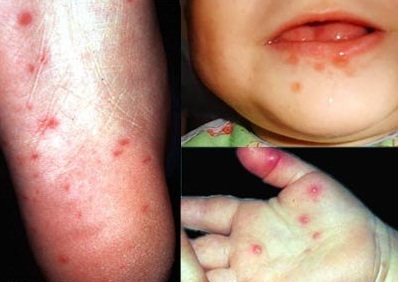Hand, foot and mouth disease (HFMD) is an illness caused by a collection of coxsackie viruses. The illness is most common amongst children under the age of five, but that’s not to say that children who are older than that age or adults can’t catch the illness. Its name derives from one of the symptoms—small sores on the hands, feet and mouth. The disease, most common from spring time to autumn, is contagious, but how long is it contagious? Continue reading to find out.
How Long Is Hand, Foot and Mouth Contagious?
The first week of HFMD is usually when a person poses most risk of infecting others and the disease is most contagious. People with HFMD should also note that even if the symptoms subside or they show no symptom at all, they may still pose the risk of infecting others.
The virus which causes the disease can be found within an infected person's throat and noses excretion, such as saliva, nasal mucus, fluid within blisters and feces. The saliva can maintain the virus for about two to three weeks and the feces can keep it for as long as eight weeks. Therefore, maintaining good hygiene at all times, such as washing your hands constantly, is always advised. Also avoid close contact with the infected people and pay special attention to the possible contaminated areas such as public restrooms and swimming pool.
If you think that you may have hand, foot and mouth disease, it is important you remain indoors and away from the others so as to not spread the illness. Speak with a health care provider to best ascertain when you can reestablish your normal day-to-day routine.
How Long Does Hand, Foot and Mouth Disease Last?
The fever that many individuals experience usually lasts around two to three days. The ulcers/sores usually take around one week to diminish. Rashes on the hands and feet can last for around ten days, after which they may start to peel. There are other complications such as dehydration, associated secondary bacterial infections, febrile seizures, or meningitis which is less common but more severe and requires immediate hospitalization and treatment.
How to Identify Hand, Foot and Mouth Disease
It is necessary to ascertain the symptoms and signs which can help to identify the illness after answering the question "how long is hand, foot and mouth contagious". These symptoms include: fever and vesicles (small and fluid-filled sacs) on cheeks, gums and tongue, usually starting out as small red dots but eventually blister or become ulcers. Individuals may also experience papulovesciular lesions (eruption pertaining to papules and vesicles) on their soles, palms and/or fingers. On some occasions, maculopapular lesions also occur on an individual's elbows, knees, genital and/or buttocks area. The sores around the mouth can be highly painful, making it hard to drink fluids and lead to dehydration. Other less common complications of HFMD include ascetic (viral) meningitis (which can cause stiff neck, headache and sensitivity to light), brain inflammation, paralysis, fluid in the lungs or loss of finger and toe nails.

Treatment for Hand, Foot and Mouth Disease
1. Take Paracetamol or Ibuprofen
Both Paracetamol and Ibuprofen can work to lower one’s temperature. They can also help to reduce pain associated with mouth sores. These medicines can be taken by both adults and children. There are many medical products available at the pharmacy containing these ingredients tailored for different age groups.
2. Keep Cool
If you have a fever resulting from HFMD, keeping cool will be highly beneficial. Maintain a good flow of air throughout your house by keeping windows open. You can also use an electric fan or air conditioning. It's important to note that using a cold sponge to cool your child's temperature down is not advised even if it used to be very popular. This is due to the fact that the blood vessels beneath the skin can become narrow when the water is too cold. The heat may be trapped as heat loss is reduced, exacerbating your child's condition.
3. Stay Well Hydrated
Drink plenty of fluids to prevent dehydration. If your mouth is too sore to drink, try taking Paracetamol or Ibuprofen first and then drink some fluids when you feel better. If your child has HFMD whilst still at the nursing age, continue to breastfeed as this is the best fluid they can possibly obtain.
4. Treat Sore Mouth
A sore mouth associated with HFMD can be highly irritating and cause much discomfort. Thankfully there are numerous treatment methods for sore mouths. It should be noted that not all of these medications are appropriate for children. Consult the doctor before taking or applying them:
- Lidocaine Gel
This local anesthetic works to numb the area and reduce pain, this medication is usually suitable for children.
- Benzydamine
Applied locally to the area, this treatment can be effective to relieve sore mouths. It can be given to children from the ages of five and upwards.
- Choline Salicylate Gel
Although this treatment is effective, it should never be used in children or by pregnant women.
- Saline Mouthwash
Make a mouthwash out of warm water and salt. Rinse and spit to relieve the symptoms.
Discuss with your doctor for more treating options. You should work alongside their guidance to help assuage mouth soreness and other symptoms associated with HFMD. When ascertaining the answer to the question "how long is hand, foot and mouth contagious", your doctor can also help to determine whether the disease is still present and contagious.
